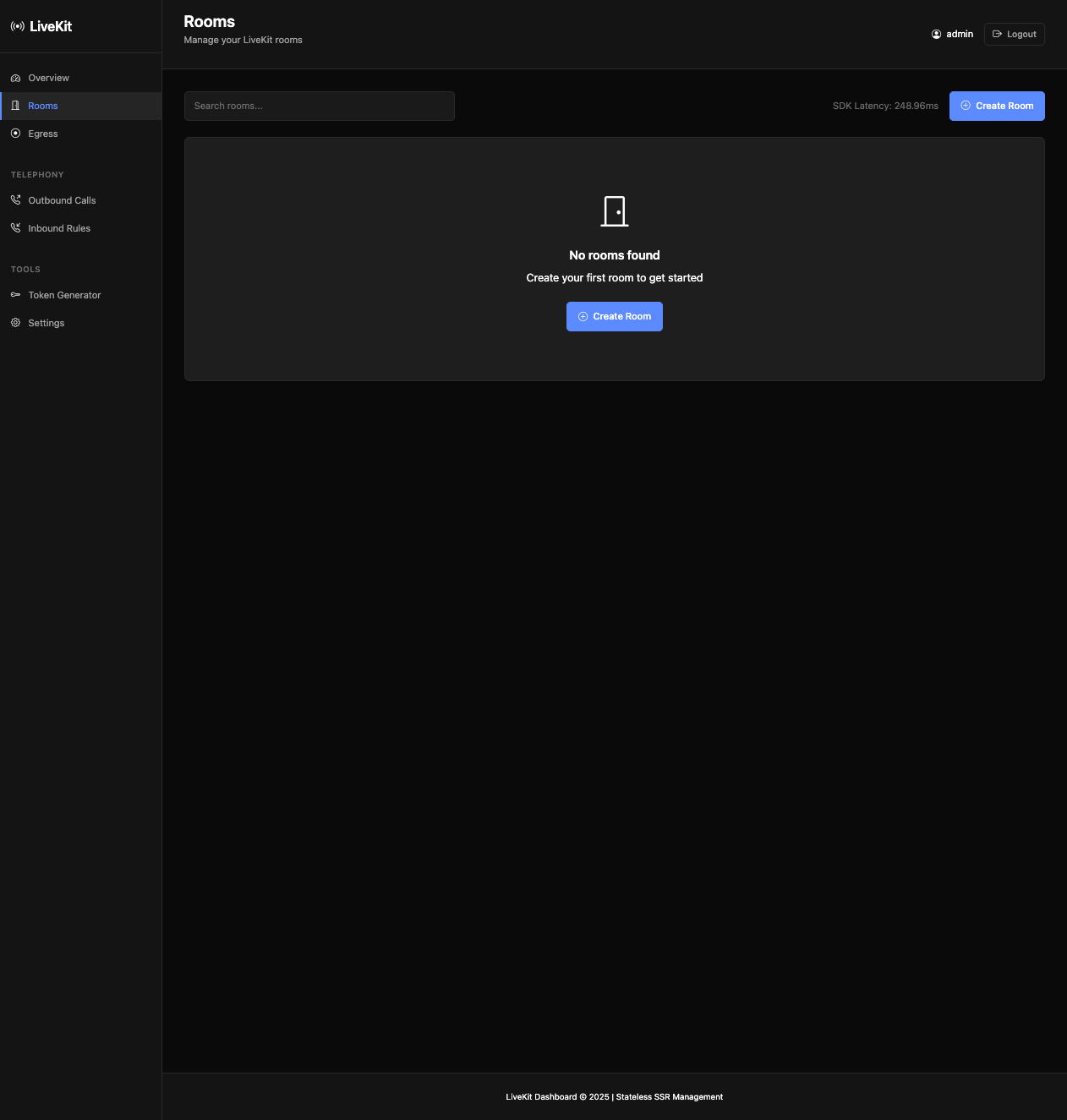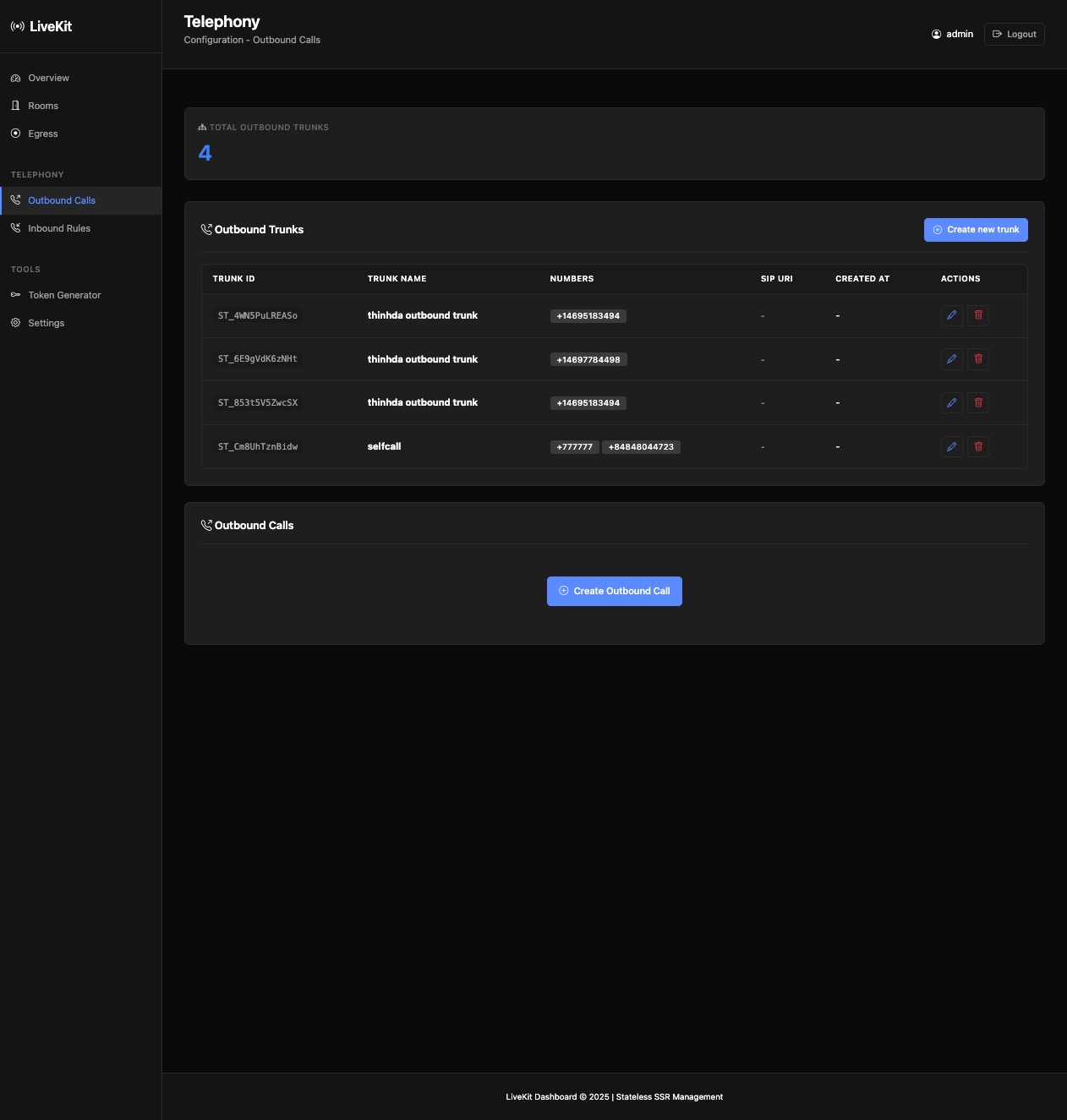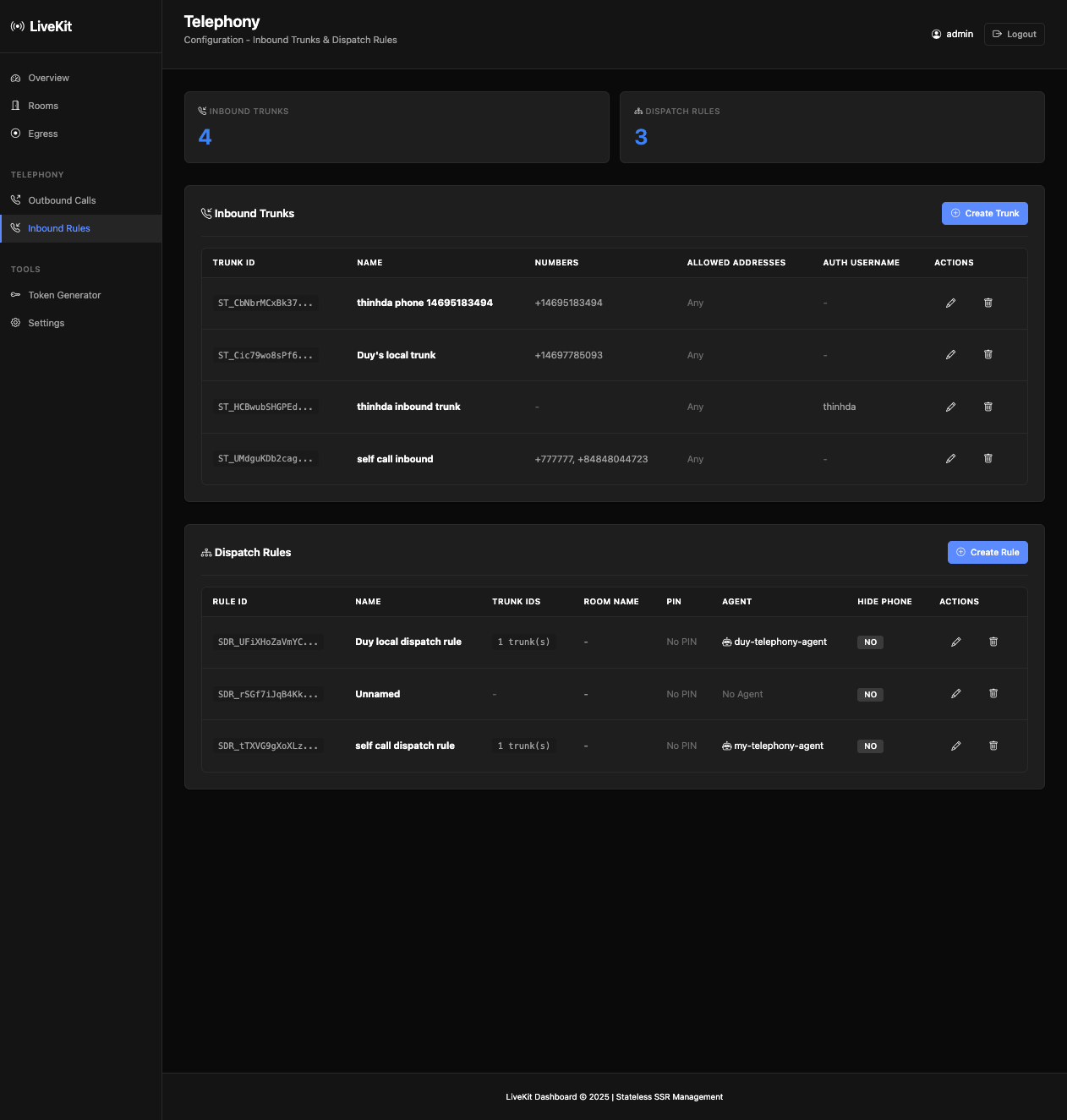Running LiveKit at scale is powerful — but it can also feel like you’re managing a live concert with the lights off. You’ve got rooms, participants, servers, and recordings all moving at once, and without a clear dashboard, visibility becomes guesswork.
Typical pain points include:
- Using CLI to access Livekit cluster
- Writing ad-hoc scripts to query APIs
- Manually tracking who’s connected where
- Managing egress jobs without clear feedback
- No unified view of SIP or telephony integrations
If that sounds familiar, you’ll immediately see why LiveKit Dashboard exists — it turns that scattered workflow into a single, actionable control panel.
What Exactly Is LiveKit Dashboard?
LiveKit Dashboard is a stateless, self-hosted management app built with FastAPI and Jinja2. It communicates directly with your LiveKit servers using the official Python SDK — fetching live data on demand, with zero persistence or external dependencies.
Design Principles That Keep It Simple
- Stateless by Design – No database or background workers. Every request reflects real-time data.
- Self-Hosted First – Deploy anywhere, stay in control of your infrastructure.
- Security-Focused – Includes HTTP Basic Auth, CSRF protection, and hardened security headers.
- Progressively Enhanced – Runs without JavaScript, upgraded with HTMX for real-time interactions.
Key Features That Make Operations Easier
🏠 Overview Dashboard

Your “cockpit view.” Monitor room counts, participant distribution, SFU health, and API latency — refreshed every few seconds.
Example: A DevOps engineer can spot API latency spikes within seconds instead of waiting for alerting tools to trigger. It’s like watching your cluster’s heartbeat live.
🚪 Room Management

Create, view, and control rooms instantly — with visibility into active participants, tracks, and session states.
Real-World Use Case: Imagine a live streaming platform where a user reports “no video.” You open the dashboard, drill into the room, and see that their video track is muted — no SSH, no script, no waiting.
👥 Participant Controls
View participant connection health, media tracks, and latency metrics — and manage permissions or remove users with a single click.
This transforms support from “reactive triage” to “proactive resolution.”
📹 Egress and Recording Management

Start composite recordings, monitor live jobs, and download finished files — all from the browser.
Before: Running curl commands and checking job IDs manually. After: Click “Start Recording,” watch the status live, and access the file when done.
📞 Optional SIP Integration


Manage SIP trunks, routing, and telephony workflows directly from the interface when enabled.
🧪 Token Generator Sandbox
Quickly generate test tokens with configurable roles and TTLs. Perfect for debugging or validating new room settings before deploying to production.
Under the Hood: A Simple Yet Scalable Architecture
User Browser ─▶ FastAPI + Jinja2 (SSR) ─▶ LiveKitClient SDK ─▶ Your LiveKit Server
Why this matters:
- Horizontally scalable: Run multiple instances with no coordination
- Always current: Every page fetches live data
- Resilient: Restart anytime — no state to lose
- Lightweight: Minimal CPU and memory usage
Getting Started in Minutes
🐳 With Docker
git clone <repository-url>
cd livekit-dashboard
cp .env.example .env # Add your credentials
make docker-run
💻 Manual Setup
make install
export LIVEKIT_URL="https://your-livekit-server.com"
export LIVEKIT_API_KEY="your-api-key"
export LIVEKIT_API_SECRET="your-api-secret"
export ADMIN_USERNAME="admin"
export ADMIN_PASSWORD="secure-password"
make dev
Then visit http://localhost:8000 and log in — your LiveKit world, finally visible.
Before & After: Real Operational Wins
Scenario 1: Debugging Connection Issues
- Before: Using CLI to query the API.
- After: Open Dashboard → see 15 rooms, 127 participants → spot one room with connection drops → inspect the participant → fix instantly.
Scenario 2: Recording Oversight
- Before: Manually track egress job IDs.
- After: Dashboard shows all active recordings, with real-time job status and instant access to download URLs.
Scenario 3: Capacity Planning
- Before: Write API queries to calculate load.
- After: Dashboard overview shows distribution by room size and participant platform — updated automatically every few seconds.
These aren’t just convenience improvements — they directly reduce downtime and support overhead.
Built for Real-Time Reliability
Real-Time Analytics Example
async def get_enhanced_analytics(self):
# Fetch live participant metrics
...
return {
"connection_success": calculate_success_rate(),
"platforms": {
"Web": 60,
"iOS": 20,
"Android": 15,
"React Native": 5
}
}
Security First
def verify_credentials(username, password):
return secrets.compare_digest(username, expected_user) and \
secrets.compare_digest(password, expected_pass)
Your credentials never leave your environment — no third-party calls, no logs.
Current Limitations & Roadmap
Today:
- Single admin account
- No historical trend tracking (stateless)
- Basic participant control (kick/mute only)
Coming Soon:
- WebSocket updates
- Rich participant analytics
- Recording previews
- Mobile-friendly UI
- Optional persistent analytics
Quick FAQ
Does it work with LiveKit Cloud? No — it’s built for self-hosted LiveKit servers where you control API access.
Is it secure? Yes — all data flows within your own environment. No external services involved.
Can I extend it? Absolutely. Add routes, analytics, or custom integrations easily — it’s open and modular.
Resource usage? Lightweight — runs on a single core and 512 MB of RAM.
Example Configuration
LIVEKIT_URL=https://your-livekit-server.com
LIVEKIT_API_KEY=your-api-key
LIVEKIT_API_SECRET=your-api-secret
ADMIN_USERNAME=admin
ADMIN_PASSWORD=secure-password
ENABLE_SIP=false
Why This Matters: From Monitoring to Mastery
For teams running real-time systems, visibility is power. The LiveKit Dashboard turns management from reactive firefighting into confident, data-driven operation.
You don’t just “check if things work” — you see them working.
Start now:
Built with ❤️ for developers who love clarity and control.



